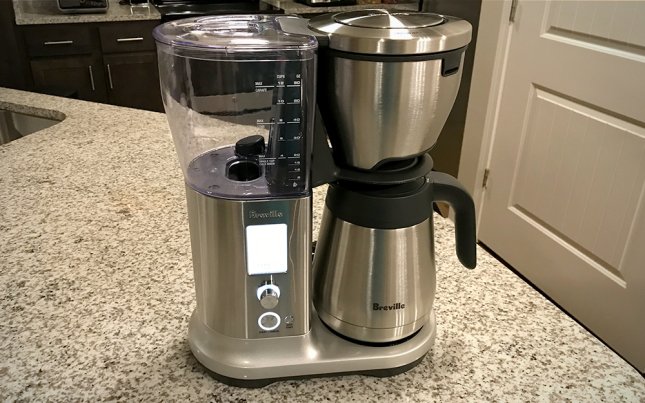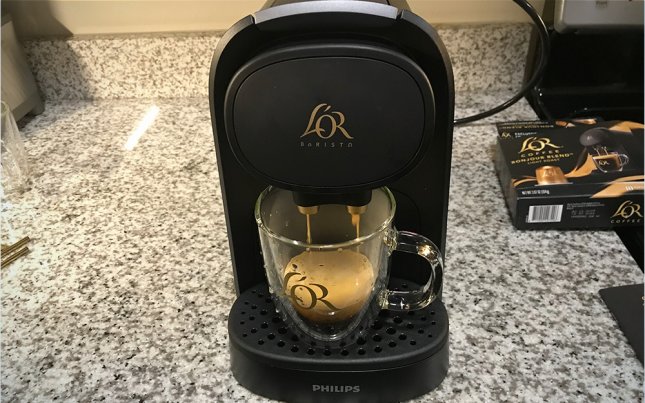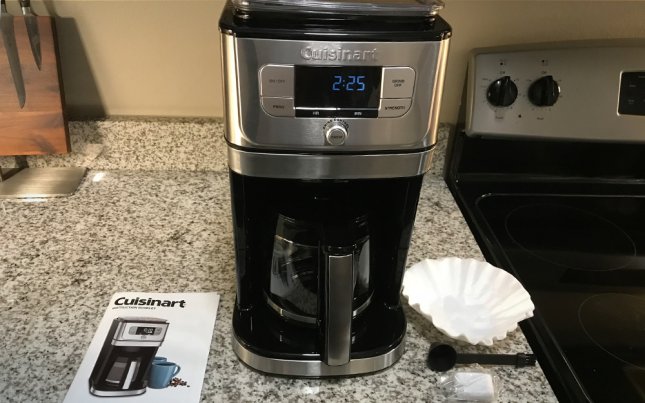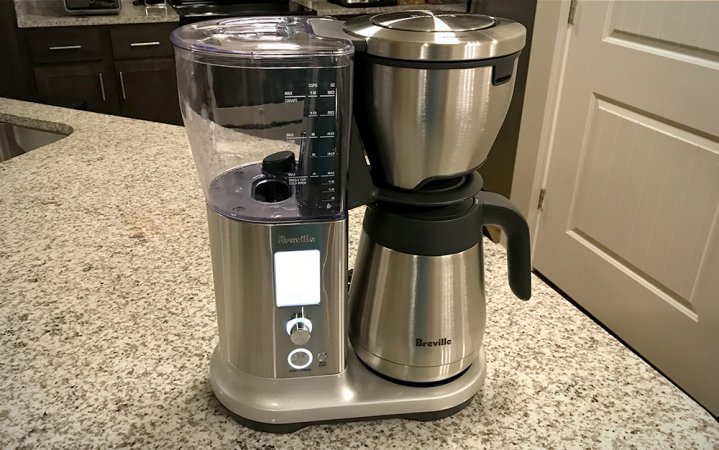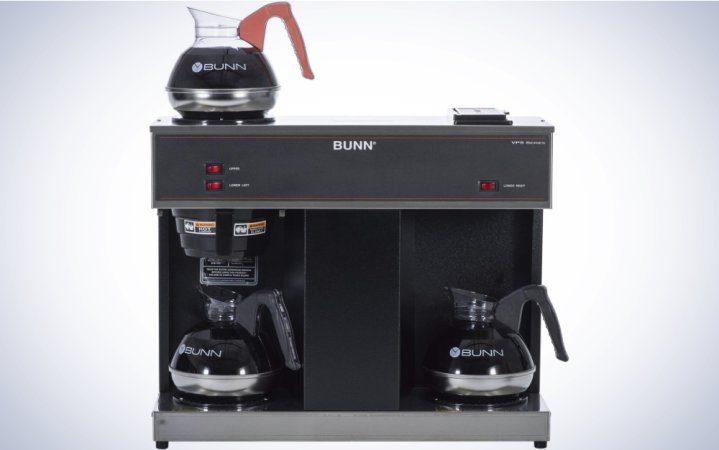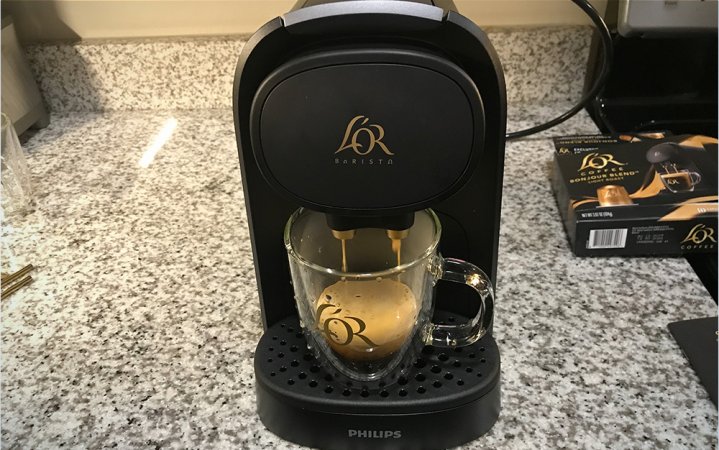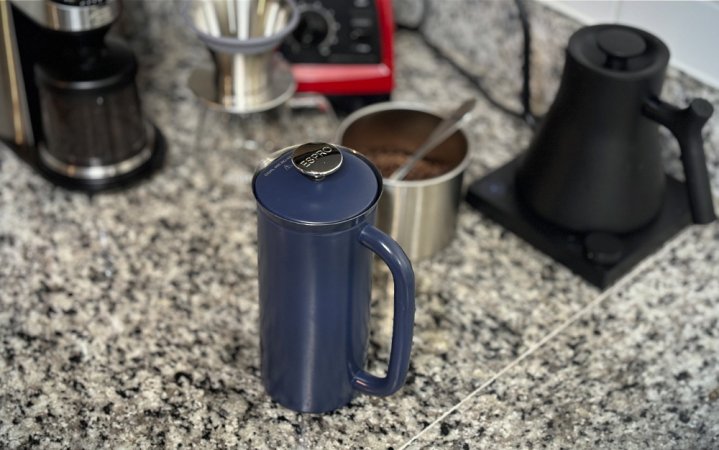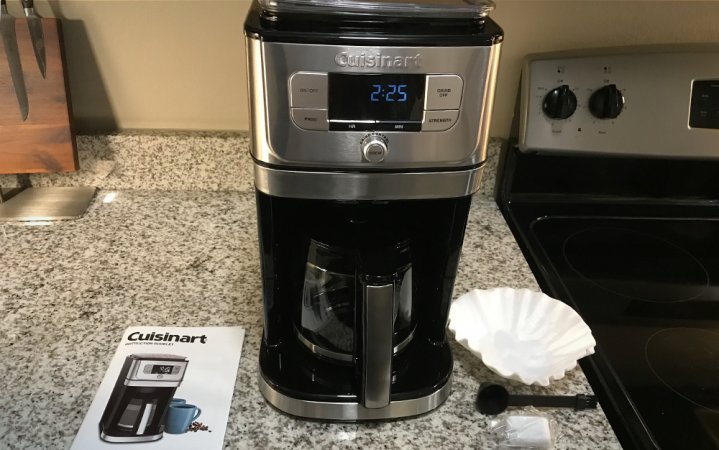We may earn revenue from the products available on this page and participate in affiliate programs. Learn more ›
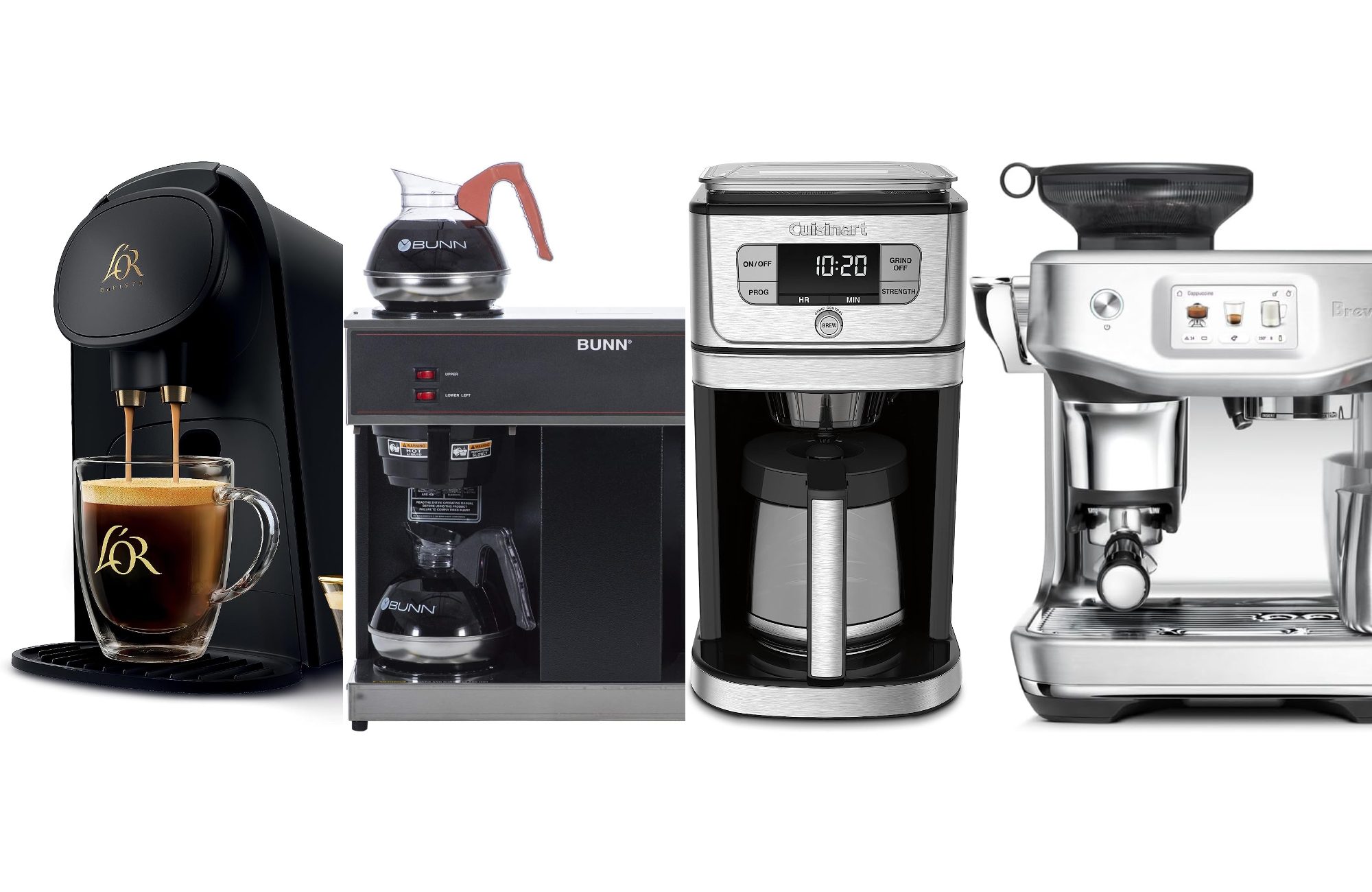
You’re not alone if you like to jump-start your day at the coffee machine. According to a report by the National Coffee Association (NCA), 63% of Americans drink coffee daily, making it the most consumed beverage—even more popular than water. The report also reveals that 36% of Americans say they have an in-office coffee station.
In the past, many offices were limited to commercial coffee brewers with warming plates. However, those models often resulted in bland and/or burnt coffee that didn’t get any better from sitting on a hot plate for too long. These days, however, coffee-maker manufacturers make affordable retail models with many of the bells and whistles you’d find in commercial coffee makers. The best coffee makers for offices can cater to cubicle coworkers’ and C-suite executives’ tastes alike without exceeding space or budget restrictions.
- Best overall: Breville Precision Brewer
- Best splurge: Breville the Barista Touch Impress
- Best for large groups: Bunn 12-Cup Commercial Coffee Brewer
- Best single-serve coffee maker: L’OR Barista
- Best French Press: Espro P7 French Press
- Best value: Cuisinart Automatic Grind and Brew
How we chose the best coffee machines for offices
As a freelance journalist for over 10 years, I’ve reviewed home and tech products for publications including Forbes, CNN Underscored, NBC News Select, Popular Mechanics, Architectural Digest, Tom’s Guide, The Daily Beast, USA Today’s Reviewed, TechRadar, Better Homes & Gardens, Bob Vila, and, of course, PopSci. I’ve tested and written several dozen coffee makers and combined this experience alongside interviews with several coffee experts for tips on choosing the best coffee maker(s) for this type of setting.
The best coffee machines for offices: Reviews & Recommendations
Giorgio Milos, master barista for illy, tells us, “Good and well-prepared coffee at offices is a thing that should be available all the time and independently of who’s making the coffee.” He admits, however, that people are not born with the skills to make it right; some knowledge and training are necessary to make coffee properly.
“Filter coffee is easy to prepare and maintain with very little training and knowledge, but making espresso-based drinks properly requires extensive training, practice, and passion,” he says. “On the other hand, single-serve pods or capsules are made to avoid the requirement of skills.”
For office managers in the market to purchase a coffee maker, these are some NCA stats to keep in mind: Among people who drink coffee, the most popular preparation method is drip coffee (40%), followed by single-cup brewers (27%), cold brewing (16%), and espresso machines (11%). In addition, the most popular espresso-based beverages are lattes (18%), espressos (16%), and cappuccinos (15%). Based on testing, our experience with coffee makers in office settings, and the factors explained by our experts at the end of this roundup, here are the best coffee machines for offices that offer all types of extraction and allow you to leave behind that travel mug of homebrew without regrets.
Best overall: Breville Precision Brewer
Why it made the cut: The large-capacity coffee maker is durable, easy to use, and looks good in any space.
Specs
- Dimensions: 14” x 9” x 16”
- Weight: 3.15 pounds
- Brewing capacity: 60 ounces
Pros
- Six brewing presets, including fast, strong, and cold brew
- Programmable
- SGA Gold Cup standard certification
- Thermal carafe
- Easy to use
- 60-ounce capacity
Cons
- Adapter kit for pour-over option sold separately
The Breville Precision Brewer leads our list of the best drip coffee makers and is also our top pick for the best office coffee machines. The Breville Precision Brewer can brew 60 ounces (12 cups) of coffee. However, it also has a small cup detection feature for office workers who want to brew a single-serve volume. In addition, the coffee maker has several settings, including SCA Gold Cup, Fast, Strong Brew, Ice Coffee, and Cold Brew. SCA (Specialty Coffee Association) Gold Cup certification is only awarded to a handful of coffee makers, and certification is determined by various factors, including brew basket volume, temperature, uniformity of extraction and performance, holding receptacle and temperature.
It’s easy to use, another reason this is a great coffee machine for office use. After pressing the start/cancel button, there’s a select dial, and the selection shows on the display panel. The coffee maker also has a “time since brewed” feature, so anyone walking up to the machine can see how fresh the coffee is.
It’s a durable coffee maker made of brushed stainless steel with a thermal carafe. I like thermal carafes because they can keep coffee hot without using a warming plate. In an office setting, a thermal carafe is also a heavy-duty option that won’t break if it’s accidentally dropped on the floor, unlike fragile glass carafes. Also, more manually minded caffiends can use the Breville Precision Brewer with a pour-over dripper.
Best splurge: Breville the Barista Touch Impress Espresso Machine
Why it made the cut: The step-by-step instructions make this great for beginner baristas.
Specs
- Dimensions: 14.2” x 13.4” x 16.3”
- Weight: 22 pounds
- Brewing capacity: 12 ounces
Pros
- Onscreen guidance
- 9 bar extraction pressure
- Hands-free milk texturing
Cons
- Expensive
Don’t underestimate your officemates’ ability to use and appreciate high-end coffee makers. Many of them may have high-end espresso machines at home, and others, especially those who visit their favorite barista every day, may be willing to learn how to recreate their favorite drinks at work. Having a proper latte machine at the office saves them time and money and can help create a sense of camaraderie in the office. And the Breville Barista Touch Impress is actually a beginner-friendly automatic espresso machine with settings for flat white, latte, cappuccino, long black, babyccino, hot chocolate, tea, and more.
The 12-ounce bean hopper holds whole beans until you want the integrated burr grinder to transform them into ground coffee. Also, the generous 67.6-ounce water tank eliminates having to refill it continuously. The Thermojet heating system heats up quickly, and the automatic steam wand provides a silky microfoam layer on top of the coffee that beats a simple milk frother. In addition, settings for alternative milk types (almond, oat, soy) can also be selected for latte-based drinks.
Best for large groups: Bunn 12-Cup Commercial Coffee Brewer
Specs
- Dimensions: 8” x 23” x 19.2H
- Weight: 25.6 pounds
- Brewing capacity: 12 cups
Pros
- Three warming stations can keep 36 cups of coffee warm
- Can designate regular or decaf decanters
- Simple, easy-to-use buttons
Cons
- Temperature recovery period
If you need to make coffee for many people, the Bunn 12-Cup Commercial Coffee Brewer lets you brew up to three carafes (or decanters) of coffee and keep them hot on the three warming stations. The warming stations are each separately controlled. And for large events, like meetings and office parties, you can continue to brew coffee rapidly. In fact, this stainless-steel, easy-to-use commercial brewer makes 3.8 gallons of coffee per hour.
There’s another advantage to such commercial coffee machines. A Bunn allows you to brew fully leaded and decaf coffee simultaneously and keep them in carafes with a color-coded handle. This allows you to accommodate those who may be trying to cut down on their caffeine consumption. You can brew two carafes of coffee back-to-back, but then there’s a temperature-recovery period before the third carafe can be brewed.
Best single-serve coffee maker: L’OR Barista System Coffee and Espresso Machine
Specs
- Dimensions: 16” x 7” x 11”
- Weight: 11.02 pounds
- Brewing capacity: 12 ounces
Pros
- Uses a variety of coffee and espresso capsules
- Heats quickly
- 40-ounce detachable water tank
Cons
- Single-serve use only
If you have a small office that enjoys single-serve coffee, they can customize each cup with the L’OR Barista System Coffee and Espresso Machine—a fully automatic machine that is quite easy to use. After pressing the Power button, just press the Small icon for a 5-ounce coffee or a 1.4-ounce espresso. The Medium icon produces 8 ounces of coffee or 2.7 ounces of espresso. The Large button is used for 12 ounces of coffee or 3.7 ounces of espresso.
The L’OR Barista can accept both large coffee capsules and small espresso capsules, producing a velvety layer of crema on top every time. Some coffee blends offered include Vanilla Flavored Blend, Bonjour Blend, Chateau Blend, Provocateur Blend, Le Tigre Blend, and Decaf Medium Roast. Some of the espresso capsules include Ristretto, Colombia, Ristretto Decaffeinato, Onyx, Profondo, Estremo, Forza, Chocolate, Vanilla, Caramel, and Papua New Guinea. L’OR single-serve coffee makers are also compatible with Peet’s Coffee capsules and Nespresso Original machine capsules (another popular style of office-friendly coffee maker).
Best French Press: Espro P7 French Press
Specs
- Dimensions: 3.5” x 4.2” x 9.5”
- Weight: 1.5 pounds
- Brewing capacity: 32 ounces
Pros
- Makes good, strong coffee
- Double filter keeps coffee sediment-free
- Gorgeous, space-saving design
Cons
- Plunger can be tricky
It’s been said that no coffee tastes better than properly prepared French Press coffee. If there are a few coffee snobs in your office, the Espro P7 French Press can provide the level of flavor that they’re unlikely to get from another brewing method. That’s because you can fully control the brewing process (using the plunger) in a way you can’t with most other types of brewing processes. The Espro P7 has a double micro-filter to ensure that no grit or sludge can make it into your cup—and it brews coffee in 4 minutes. In addition, since the stainless-steel French press has double-walled insulation, it keeps coffee (or tea) hot for hours with no degradation of taste.
The Espro P7 is available in 18- and 32-ounce sizes. It’s also available in several colors, including matte black, matte white, Aegean blue, cranberry, brushed stainless steel, and polished stainless steel. Of course, you’ll need a good source of hot water for a French Press, like the temperature-controlled Stagg EKG Pro Studio Electric Gooseneck Kettle—one of our top gift suggestions for the hot beverage-obsessed.
Best value: Cuisinart Automatic Grind and Brew
Specs
- Dimensions: 8.74’ x 16.34” x 11.96”
- Weight: 15 pounds
- Brewing capacity: 12 cups
Pros
- 12-cup carafe
- Programmable
- Bean hopper/grinder
- Grind-off feature
Cons
- Glass carafe
Nothing tastes better than freshly ground coffee beans, and the Cuisinart Automatic Grind and Brew can save you the space and expense of a dedicated grinder. The bean hopper, which holds half a pound of coffee beans, has a lid to keep the beans fresh, and the built-in burr grinder has a grind control knob to make the ground finer or coarser, as desired. However, there’s also a Grind-Off feature when using pre-ground coffee.
The coffee maker also has several other convenience features. For example, it can be programmed up to 24 hours in advance so that officemates can arrive to freshly brewed coffee each day. In addition, the brew strength can be controlled, and there’s a Brew Pause feature if someone wants to cheat and grab a cup of coffee before the carafe has finished. (I strongly advise against that since it weakens the remaining coffee.) The 12-cup carafe has a dripless spout. However, the carafe is made of glass, which doesn’t retain heat as well as a thermal carafe. But considering that it’s a 12-cup coffee maker with a built-in grinder, we also consider this the best value when looking for a coffee maker for the office.
What to consider when buying coffee makers for an office
There are many factors to consider when deciding which coffee maker for an office is right for you. Below are the factors we considered most important when writing this guide.
Machine type
The type of machine you purchase is the most important decision, and our experts had the most comments on this particular topic. “Consider your available budget, the number of employees that will be brewing coffee, the machine’s durability, and the counter space available in your office kitchen,” says Dr. Christina Rahm, founder and CEO at Rahm Roast Coffee in Franklin, Tenn.
She notes that single-brew coffee machines are popular because they tend to be cost-efficient, require minimal countertop space, and are easy to clean. “Utilizing a pour-over or French press, which is what we use in our office, is undoubtedly one of the finest ways to achieve a fresh and flavorful cup of coffee,” Rahm explains. “In a smaller office setting, this is a great option to consider.”
Caroline Bell, founder and CEO of Cafe Grumpy, agrees you want something easy to use. “However, you also want something that produces a good cup of coffee, so your team will want to take their coffee break in the office,” she says. “After establishing your budget, consider how many people will be using the machine and whether or not you want to have something that allows people to brew one cup at a time or a pot of coffee to share.”
And Bell recommends just the right amount of fresh ground coffee. “Although pods allow you to offer different types of coffee one cup at a time, having fresh ground coffee will give your team a better coffee experience, including those nice aromas.”
If you’re in a small office, Bell says investing in a coffee grinder and some pour-over equipment might be a good idea so people can brew individual cups and try different coffees. “On the other hand, if you have a big budget and a large team, you might want to splurge on an automatic espresso machine,” she says.
According to Shonali Paul, founder of Paul John Indian Caffeine Company, “The ideal solution for offices would be an automatic machine that brews at least three different coffees: an espresso, an Americano, and a latte,” she says. “That way, the possibilities are endless and will cater to all your employees’ likes.”
Paul is also a fan of machines with built-in bean grinders (pro tip: keep a small spray bottle of water handy to cut down on static and stray grinds). “This also gives you the option to try many different roasts and blends—while grinding them on demand, so they stay fresh for longer.”
If there’s no coffee professional in charge, Milos (master barista for illy) recommends a system that avoids most potential errors in preparation. “Filter coffee is much easier to manage, and it can be set in offices regardless of the skills of the users,” he says. “Assuming all preparation variables are set—water temp, ratio coffee/water, grind size, and more—the two main rules are maximum two hours of consumption time, and the equipment must be cleaned every day.”
Settings
When making your choice, consider which coffee machines provide ease and functionality. “Look for coffee makers with settings such as cup size, brew strength, a timer feature, and whether the machine can brew espresso shots or provide hot water for other beverages [don’t forget the tea drinkers in your company],” Rahm says. “Not all settings are created equal, so focus on the settings that would best benefit your team members.”
Capacity
Capacity is an important factor, depending on the number of people in your office. “Keep in mind the number of employees in your office, and regardless of what you choose, make sure it can provide enough fresh coffee for the number of employees working,” Rahm says.
User-friendly interface
Next to the type of machine, Rahm says the second-most important decision to consider is the interface. “The last thing anyone wants to do when they want to brew a cup of joe is read an instruction manual,” she says. “Digital interfaces can offer a multitude of settings at a click, while traditional knobs or buttons are more straightforward but still effective at getting the job done.”
Additional tips
Whatever you decide, Bell recommends making the coffee station a fun place where people can add their own touches, with options like alternative milks, cinnamon and/or cocoa, fun mugs, and other accessories like the ones you would want to give or get.
Paul agrees and recommends getting creative. “For example, provide even more of a variety of coffee flavors by having different syrups to add,” she says. “Giving employees the chance to savor different flavors in the workplace can really change their coffee experience throughout the day.”
FAQs
Most Americans drink coffee and many expect companies to provide coffee makers in an office setting. In-office coffee makers provide convenience for employers who don’t have time to stop by a coffee shop during their morning commute. It can also help them save money. Lastly, gathering around the coffee maker provides an opportunity for workers to socialize temporarily.
It depends. We provided a variety of coffee makers and espresso machines, realizing that people have different tastes. However, I have noticed in numerous office settings that when a high-quality espresso machine is available, people tend to flock toward it and suddenly start drinking espresso-based drinks. Some eventually purchase an espresso machine for their home. However, if, for example, you only have two or three people interested in a high-end espresso machine, it may not be worth the investment.
An automatic coffee maker is easier for most office workers to operate. However, just as companies expect office workers to learn new processes and technology, they can also quickly learn how to use coffee makers. Employees are at work for eight hours a day, and the desire to create the perfect coffee is a task they’re more than up to tackling.
Final thoughts on the best coffee machines for offices
- Best overall: Breville Precision Brewer
- Best splurge: Breville the Barista Touch Impress
- Best for large groups: Bunn 12-Cup Commercial Coffee Brewer
- Best single-serve coffee maker: L’OR Barista
- Best French Press: Espro P7 French Press
- Best value: Cuisinart Automatic Grind and Brew
When considering the best coffee machine for an office, the 12-cup Breville Precision Brewer is durable and easy to use. It’s a drip coffee maker that can also be used to make pour-over coffee. However, there are a variety of other coffee makers, some with grinders and others with espresso features, that may also appeal to various team members. If you have the budget for it, consider creating a coffee bar that includes two or three different types of coffee machines.
